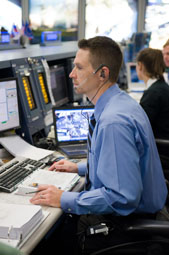
Physics Major
Johnson Space Center, Barrios Technology, Houston, Texas
Current projects
I am an Extravehicular Activities (a.k.a. space walk) flight controller and instructor for NASA. This means that I plan space walks that will take place on the International Space Station (and formerly Space Shuttle) and train astronauts how to perform the space walks. When the space walks are executed, I sit console in mission control to manage the space walks and troubleshoot any anomalies that may occur. I was the lead space walk officer for the STS-130 and STS-133 space shuttle missions. The following link is a briefing that I conducted prior to STS-133 (http://www.youtube.com/watch?v=dSpSushTDVw).
Undergraduate Research
I Worked at The Center for Laser and Photonics Research (Oklahoma State University) under the direction of Dr. Richard Rolleigh. I studied transverse effects in semiconductor ring lasers by employing computer modeling and presented my findings at the 1997 National Conference for Undergraduate Research (NCUR).
How Hendrix prepared me for success
Hendrix taught me how to find solutions to difficult problems on my own and gave me confidence that I can be successful at anything I put my mind to.
Future plans
I will continue to support space walks in support of space station maintenance as well as maintenance on the hardware necessary to perform space walks. I am also involved in "analog" missions where we simulate future space travel destinations to determine the best modes of operations. At the end of August 2011, we will be simulating an asteroid mission in the Arizona desert while the operations are managed back in Houston from a control center. One of the biggest challenges, will be working with a communication delay. When we communicate with the International Space Station, a real time conversation can be had because it is only about 200 miles from Earth. To simulate working on an asteroid, which is much farther away, we will be working with a 50 second delay. This means that we are hearing what the astronauts say 50 seconds after they say it and by the time they get our response, 100 seconds will have elapsed.
My advice
When selecting a major, make sure you understand the path from where you are now to having the necessary skills for the type of job that you are interested in. In other words, be proactive in seeking out summer internships, undergraduate research, and graduate schools.